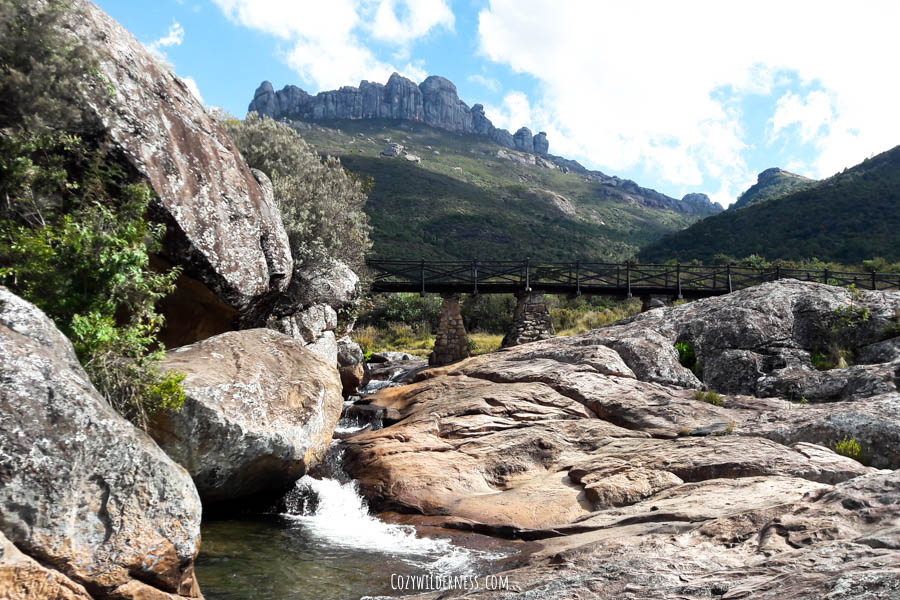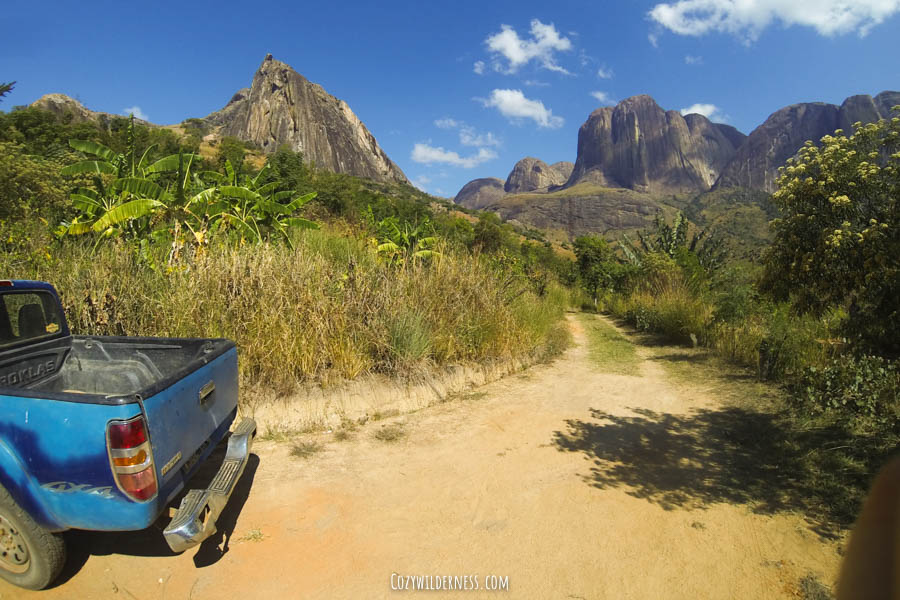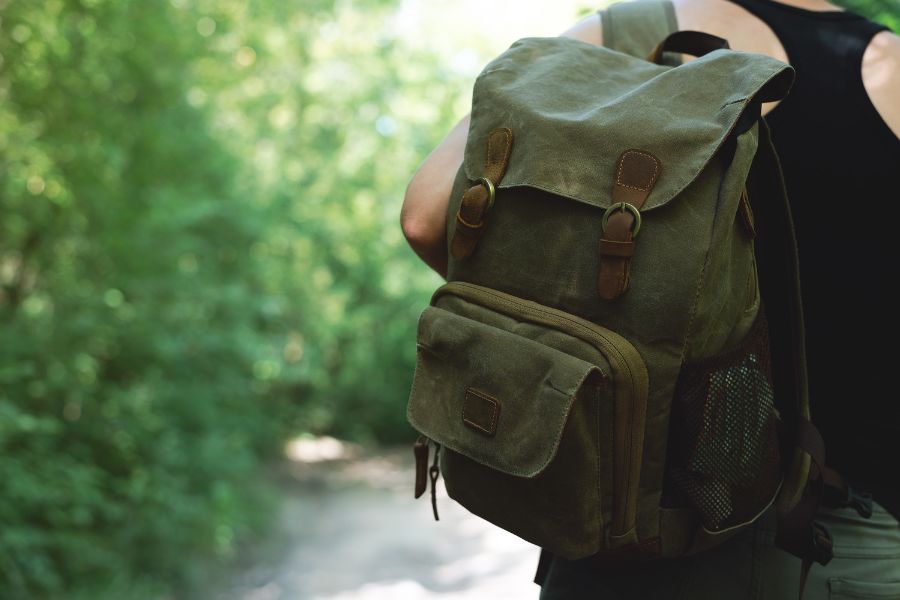

Looking for adventure stories, travel tips & hacks? You are in the right place!
Andringitra Madagascar – Explorer guide


Andringitra national park
Andringitra is a beautiful and rugged mountain massif that is home to the second highest peak in Madagascar called Pic Boby (2658 m.) and is therefore on the UNESCO World Heritage list.
In this Andringitra Madagascar – explorer guide you’ll read that this park is full of beautiful rock formations, natural pools, sacred waterfalls and some of the most scenic landscapes. But, it is also one of the most biodiverse parks of Madagascar with a lot of endemic flora and fauna species.
Tsaranoro reserve
The mountain range divides Andringitra into two parts, with on the east the Namoly valley and on the west the Tsaranoro valley. A trekking or tour through the Andringitra national park almost always starts in the Tsaranoro Reserve (valley).

The park
Andringitra lies in the southeast of Madagascar in the Haute Matsiatra region. The whole reserve covers 31,160 hectares and the altitude varies from 700 m. to the peak of ‘Pic Boby’ at 2658 m. Here you’ll encounter the most amazing landscapes, plant species and animals!
Bara & Betsileo
There’s three groups of people living inside the park borders, being the Bara people (north) and two different groups of the Betsileo (east, south & west).
Mysteries
The Andringitra national park and the Tsaranoro reserve are very mystical places for the Malagasy people. With lots of beautiful traditions and fady (taboo) this park is therefore a unique highlight on your trip to Madagascar.

How to get there
Andringitra has two different park entries, but there’s no public transport. So the only way to get there is by 4×4 on a bumpy dirt road.
Morarano entry
This is the best road to take if your are coming from the south or if you are already in the Tsaranoro reserve. The village of Andonaka is the place to stay when you’re visiting the Tsaranoro reserve and from here you’ll drive straight ahead, don’t turn right at the guide office towards the town. After about 10 min you’ll arrive at the park entrance in the town of Morarano.
Namoly entry
From Ambalavao, along the RN7, it’s about 47 kilometers to the park. Drive through Ambalavao towards the south and turn left, just before the busstop. From here it’s about 43 km on a dirt road to the town of Namoly, which should take you about 2 hours.



When to visit the park
The best time to visit Andringitra or Tsaranoro is April, May and August and September, because this is the time that the park blooms and is at its most colorful. Also, small animals are most active during these months.
Dry season & wet season
Like in the rest of Madagascar, dry season is from April to October and rainy season from
November to March.
Dry season is the best time for hiking in Andringitra, with the months of April, May, August and September being the best. The temperatures and rainfall will be mild and stable, which makes Dry season is convenient for hiking, but keep in mind that the temperatures are mostly below zero at night.

Tours & guides
In Ambalavao, about 47 km from Andringitra, you can arrange your tours & guides. Like almost all other national parks in Madagascar, you’ll need to be accompanied by a guide to explore the park. This is mainly for safety reasons, but also because they have the knowledge about flora, fauna and fady in these places.
Entrance fees Andringitra NP
Entrance price per person: 45.000 ariary (€10,65)
Community price/tax per person: 11.000 ariary (€2,60)
Guides & tour per person: 1.054.729 ariary (€250)
Keep in mind extra costs for porters, camping fees & tips.
Expect a minimum of €500 for two people, when you choose the 3 day-trekking tour to Pic Boby.

Trails & circuits
Andringitra national park boasts over a 100 km of stunning hiking trails, from easy to difficult. Here you’ll find some of the most popular trails and circuits of the park.
Disclaimer: In our opinion, the most beautiful and diverse trail is the 3 day trekking to Pic Boby, the second highest peak in Madagascar. It’s challenging at times, but definitely a rewarding experience!
Trekking to Pic Boby (3 days) - Imarivolanitra trail
This beautiful trek takes you in three days through the most beautiful parts of the national park. After your first overnight stay on a campsite in the wilderness of Andringitra, you'll rise to the summit of Pic Boby. Then descend down to the second campsite where you will stay for the night. Day three takes you to the other side of the mountain, where you will pass some villages amongst the rice fields.
Ansaramanitra trail - (6 km, 4 hours)
This is an easy 6 km hike, which is the most accessible one in the national park. You'll pass through a beautiful dense forest with a rewarding view at the end of the Riambavy waterfalls (300 m high). There's also a hidden cave to be discovered and a natural pool that brings fertility.
Diavolana (13 km, 10 hours)
This is a 13 km which takes you to the king and queen waterfalls, a strong ascend to 2100 m height and through beautiful green meadows with orchids and wildflowers in rainy season. This whole trail takes about 10 hours.
Imaintso circuit (14 km, 9 hours)
This is a 14 km loop, which takes about 9 hours and is perfect for bird lovers. You'll cross a variety of forest land, wet forest and low-altitude forest and have the chance to spot very rare bird species.
Isahavato circuit (15 km, 12 hours)
this is a 15 km long circuit, which takes about 12 hours to complete. You'll pass beautiful waterfalls and a natural pool, a high-altitude plateau and enjoy views for miles over the rocky plains below. This circuit includes one overnight stay in the national park.
Previous slide
Next slide
Flora
Andringitra national park is one of the most biodiverse places in Madagascar, with about 1000 plant species and multiple eco-zones. Most of the special plant species are found on the mountain slopes and in the high altitude forest.
Medicinal purposes
A lot of these plant species are still used for medicinal purposes by the natives living in the area, which you will hear all about during your tour through the park.
three eco zones
The Andringitra mountain range also consists of three different ecozones, which makes it such a unique environment. There’s the low altitude rainforest, the montane mountain zone and the highlands.
Rainforest
Did you know that the beautiful rainforest of Ranomafana, which you can’t miss on your trip to Madagascar, stretches all the way to Pic Boby?

Fauna
While the flora is truly unique in Andringitra, the fauna is also really diverse. Within the park live about 13 species of lemur, including the special fluffy brown lemur. There’s also a 100 different bird species, 55 frog species and 788 species of amphibians.
Ring-tailed Lemurs
The cute and world famous Ring-tailed lemurs (Catta) are often sunbathing on the mountains in the national park, particularly around Camp Catta.
Beautiful encounters
One of the most special things about trekking multiple days through a rugged national park like Andringitra, is the special nature encounters you have along the way. From rainbow grasshoppers to beautiful chameleons, you’ll find pure raw nature at its best.



Climbing
Because of the stunning mountain range that runs through the Andringitra national park, this place is also very popular for more exhilarating sports like climbing or paragliding.
The action mostly happens around the huge rock face in the Tsaranoro reserve, which has some challenging climbing routes from 3 to 8b. Some of which aren’t even bolted yet, so you if you’re up for a challenge? Easier routes can be found on the right side of Tsaranoro.
Climbing gear
If you can’t bring your own climbing gear, you can rent your gear with the one local climbing guide called Hery. Go to Camp Catta and they will set you up with climbing gear and with Hery, who also leads paragliding tours in the area.
Where should climbers camp
Camp Catta is about 40 minutes from the huge rockface, where most of the climbing routes are located, so this a good one for staying overnight. It is not the cheapest, but has a good amenities, like a restaurant and a supermarket in the next town. Also Camp Catta has a nice restaurant for your cold beer and food at the end of the day.
Soa Camp is also an option, if you want to be a little bit more independent and self-catering.

campsites
There’s a few campsites located inside the Andringitra national park. These campsites are very basic and are usually only visited for multiple day trekking, because of their location in the park.
> Andriampotsy campsite
> Lataranomby campsite
If you want a bit more luxury, you can find a few campsites outside the parks borders, like;
> Camp Catta
They have comfortable bungalows with solar water heaters and private facilities. But, they also have tents available for a more low budget option, or pitch your own tent.
> Tsara Camp
At this campsite you can stay in fully furnished tents, with beds, an outside natural shower and chemical toilet. Hot water is delivered every morning in washbasins as well.

The town of Ambalavao
The colorful houses have artistically made balconies, with lots of geometric figures and patterns. It’s in between the Andringitra mountains and marks the border between the highlands and the south. Walk through the streets of the town, buy some €0,30 moonshine rum at a street vender and get a real feel of Madagascar.
Where to stay
A good place to stay while you’re in the centre od Ambalavao is ‘La Residence du Betsileo’. It’s right in the town’s centre, which makes it a great location if you like to explore some Malagasy streets.
The owners are very kind and they have a great restaurant with good quality food. The rooms can use some updates, but it’s a great place. They also help you with booking your tour or trekking in Andringitra national park.
Want a slightly more luxurious option? Check out The Betsileo Country Lodge.


What to pack
Depending on the months you are going, you have to pack a few things when visiting Andringitra national park. In dry season it will be cold at night, like below zero cold and in the wet season you will get a lot of rain in this part of Madagascar.
So what to pack?
– light clothes, layers are best
– Long pants, or shorts but with high socks
– Bikini, swim shorts (for the natural pools)
– Good, sturdy walking shoes, not slippery
– A hat when it’s sunny
– Sunscreen
– Lots of water
– Backpack with some food,
check with your tour guide what they’ll bring
– Warm sleeping bag and pillow (check with guide)
– Camera
– Binoculars
– Tipping money for the guide & spotter

Vaccinations & Precautions
Traveling to Madagascar almost always requires you to be vaccinated for certain health risks.
Below the most common health risks and vaccinations.
– Chikungunya, Dengue and Zika virus.
These are all mosquito related, so protect yourself day and night
– Malaria. Sometimes Malaria tablets are required
– DTP vaccination
– Hepatitis A vaccination
– Hepatitis B vaccination (not always)
– Rabies (not always)
– MMR vaccination (BMR in dutch)
– Tuberculosis vaccination (not always)
– Schistosomiasis (Bilharzia). It’s a parasite, found on the surface of fresh water
– Yellow fever (only when traveling from a Yellow fever area)
Disclaimer: always contact your healthcare specialist before traveling to Madagascar.

Hi! We’re Tim & Ilse
Together with our fluffy cat Snowy we travel around the world searching for adventures.
Related Posts









